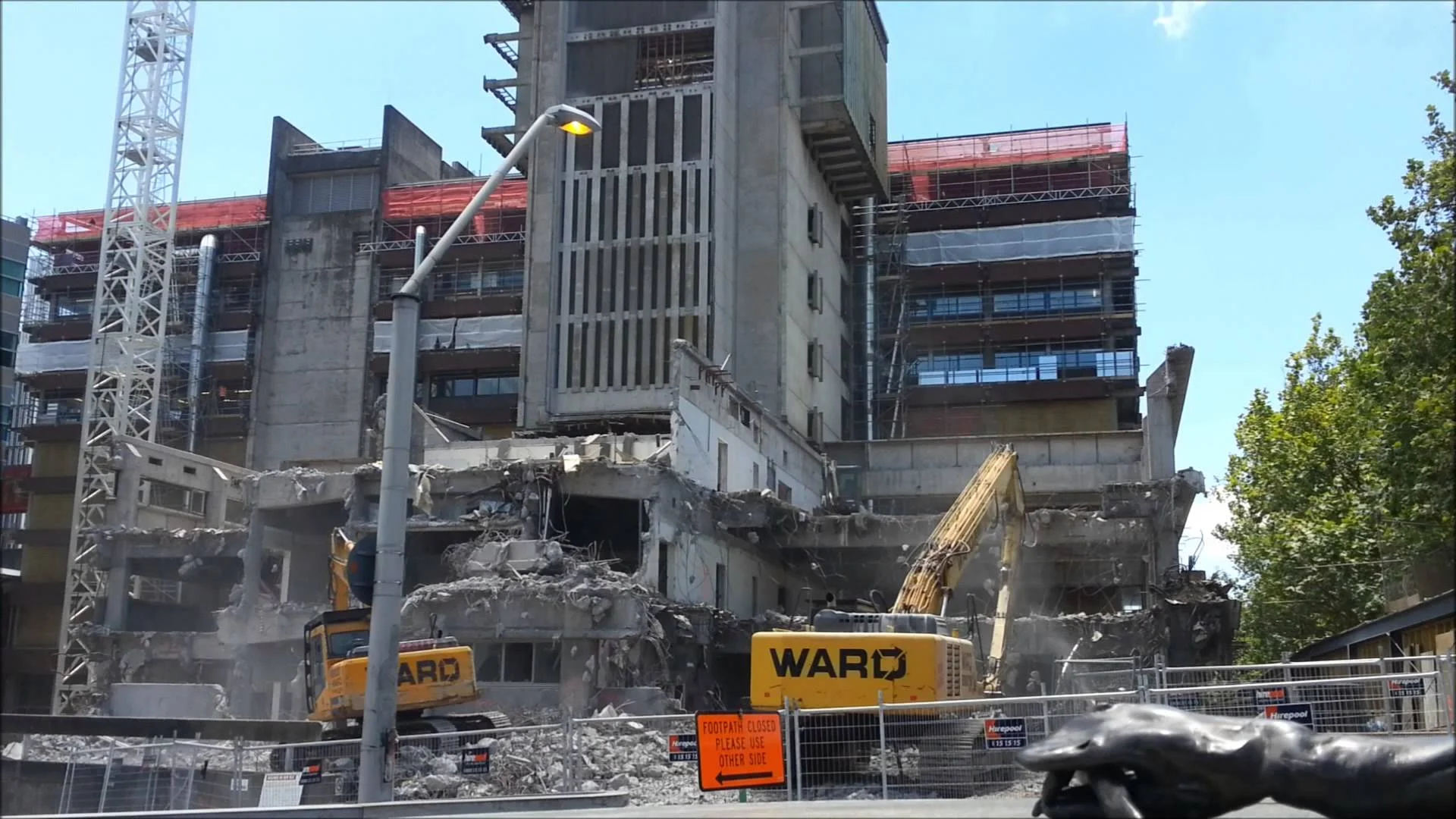In 2014 Ward Demolition were contracted by Fletcher Construction to demolish a 14 level science education building at the University of Auckland.
THE CHALLENGES:
· The building was situated in the heart of Auckland’s CBD on the intersection of a four lane road and a motorway slipway.
· A roomful of radioactive Cobalt-60 was sitting directly under the demolition site.
· The building was still connected to a ‘live’ adjoining education building, with a working science lab, conducting experiments sensitive to vibration.
· The roof of the live building had tradesmen working on it throughout the project.
· Delays before Ward’s arrival reduced the 12 weeks allowed for hard demolition to eight.
· Planning consent restraints meant limited working hours – only 7am-6pm weekdays and 7am-4pm Saturday.
· There were over 10,000 tonnes of material to remove, and truck access was restricted to a one-way single lane road.
· Once the project was underway, hidden asbestos was discovered in the concrete floor beams, and the demolition plan had to be revised on the fly.
OVERCOMING THE CHALLENGES
Needless to say, meticulous pre-planning and innovative methodology had to come into play to complete the project safely, on time, and with absolute minimum disruption to the surrounding campus and passing traffic. Here’s how Ward stayed on the front foot:
· Multiple workforces were used to meet tight deadlines, with 20 staff onsite at the peak of the operation.
· The beams containing asbestos were cut into manageable sections, sealed with foam and removed. In all 360 ACM pipes were dealt with this way.
· To keep vibrations to a minimum, the concrete wall connecting the buildings was removed using hand tools. A 50 tonne breaker was the biggest that could be used on site much of the time, and when that proved too big concrete saws were used.
· A pad was built on the sloping section to allow one truck to pull in at a time. On one day alone 88 trucks each took 20 tonnes of concrete off-site without significantly interrupting traffic flow.
· Dust suppression protocols were put in place.
· Pedestrian and traffic management plans were activated to further reduce risks.
The vault containing the radio-active Cobalt-60 was secured. After calculating stress and vibration loads, two or three layers of overlapping 20mm steel plates were laid over the concrete casement and a deflection plate laid over the area with soft padding underneath. All work near the vault was carried out by hand and rubble above crushed to reduce risk of breakthrough.
The Ward team had to cut and crane masses of steel work and concrete off the top of the building, completing separations as they descended utilising a Komatsu PC600-8 Super High Reach. Two 4.5 tonne Bobcat excavators with breakers and jaws were used to rubble material down before reaching a level where it was right for the super high-reach methodology. Breakers, pulverisers and grapples utilised on the project were all A-Ward Attachments equipment.
RECYCLING RATES
The client insisted on high recycling rates and of 9,800 tonnes of concrete removed from site, more than 9,100 tonnes was recycled – or 93 per cent. Approximately 200 tonnes of that went back into the site as fill.
AWARD WINNING RESULTS
Despite the tight site and their fair share of unforeseen conditions, the project was a great success, with zero harm and zero incidents. An intensely technical project, the collaboration between Fletcher and Construction paid off, as Ward took home the 2014 Urban Demolition Award at the World Demolition Awards in Amsterdam. Ward’s director Peter Ward didn’t expect the win.
“But the fact that we did is completely down to the incredible partnership we had with Fletcher Construction on this project. The professionalism and communication between their team and ours really was second to none. What we pulled off on that project between Ward and Fletchers was massive. To get international recognition for our efforts is the icing on the cake.”
FEEDBACK FROM FLETCHERS
The respect was mutual. Chris Tuxford, a Fletcher Construction project manager, shares his enthusiasm on the collaboration.
“At this university project, right from day one, you could feel the confidence Peter Ward brought to the table, and you just knew it was going to be a great experience…
One of the best parts of the project was right at the start when we all worked together at the round table, and came up with all the possible situations and outcomes from our collective previous experiences, something the Ward team have a lot of. With this in our armour it soon was extrapolated into one of the best Safety Plans and Work Statements I have received, no rock was left unturned and every “what if” situation explored…
Communication between us was fantastic and the guys onsite had that working attitude that meant there were no problems, just challenges.”









